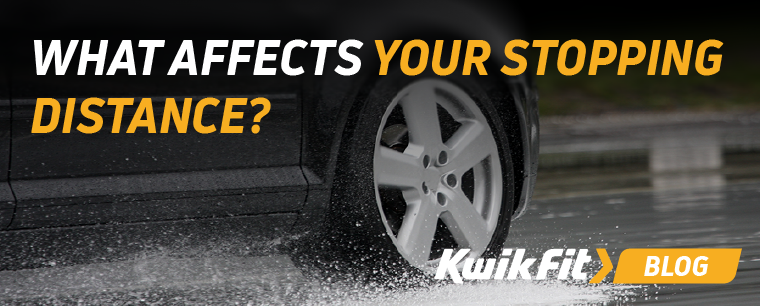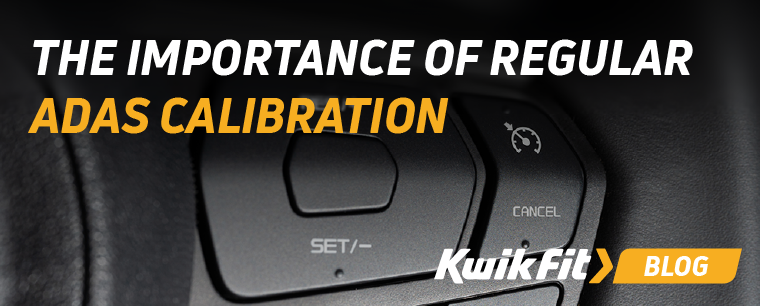What affects your stopping distance?
Kwik Fit | Thursday 6th March 2025 11:21am

Whether it’s due to a hazard in the road or the car in front stopping sharply, most drivers will have to perform an emergency braking manoeuvre at least once in their time on the road. When it happens, you’re going to want the car to stop in the shortest distance possible to avoid an accident.
In this blog, we’ll look at what makes up your stopping distance and what factors to take into consideration.
What is the stopping distance?
Your stopping distance is made up of two factors:
- Thinking distance: The time that it takes your brain to process information and react.
- Braking distance: The length you travel from pressing the brake pedal to the car coming to a complete stop.
There are several elements that can impact both of these factors, which are worth taking into consideration to achieve an optimal, and safe, stopping distance. Here are some of the things that can have an effect on how fast your car can stop, as well as what measures you can take to reduce your stopping distance.
Tyre Pressure
The pressure of your tyres plays a huge role in your stopping distance. By having the correct tyre pressure your car has an ideal amount of contact with the road, providing ample control and traction. However, when tyres are over or under-inflated, the amount of contact between tyre and road is reduced.
Underinflated tyre: Make more contact with the road on the outer edges of the tyre. This may increase your stopping distance because you’ll experience increased rolling resistance with the road. Further to prolonging your stopping distance, it’ll also reduce fuel efficiency and increase CO2 emissions.
Overinflated tyres: Have a smaller contact patch which can increase your chances of loss of traction and poorer braking distances. It can also ruin the lifespan of your tyres, due to uneven wear across the central part of the tyre.
Both types of incorrect pressure cause irregular wear of your tyres, and reduce their traction. This means your tyres are less effective at biting into the road surface and bringing the car to a halt. By doing a tyre pressure check every month and using the recommended pressure, you can better maintain your tyres and their ability to stop the vehicle. You can do this yourself, but if you’re not sure, contact your local Kwik Fit.
Tyre Wear
Another thing to consider regarding your tyres is tread depth. Legally, your tyres need to be changed when the tread depth reaches 1.6mm. However, the tread depth on your tyres can have a massive impact on your braking distance long before you reach the minimum. Most tyres start with 8mm of tyre tread, which gradually wears away with use. As the tread reduces, so does the tyre’s ability to grip the road.
At 30mph on a wet road, a car with brand new tyres will come to a stop in 25.9 metres. The same car travelling in the same conditions with tyres with a tread depth of just 3mm would come to a stop in 35 metres. That’s 35% further, despite the tyres still being perfectly legal. When the tyres reach the minimum of 1.6mm of tread, the stopping distance increases to 43 metres. That’s almost double the stopping distance of the new tyres!
Tyre Quality
You’ll also want to consider the overall quality of tyres when thinking about improving your stopping distance. Opting for premium tyres provides peace of mind that you are buying a quality product that will last. Many opt for brands like;
- Goodyear
- Michelin
- Pirelli
This is with good reason, as countless tyre tests show that premium tyres really are worth the cost due to their high performance, particularly compared to their cheaper competitors. As well as high performance, premium tyres come out on top when it comes to the control, grip and stopping distance they offer.
When travelling at 60mph, a car with premium tyres could stop as much as 16 metres shorter than a set of budget tyres. Premium tyres have other proven benefits, including increased fuel efficiency, lifespan and aquaplaning resistance.
Speed
For example, at a speed of 20 mph, you typically travel 6 metres before you make the decision to brake. With braking distance at this speed, it takes another 6 metres to come to a halt; that’s an average of 12 metres to come to a complete stop.
With every 10mph above this, your thinking distance increases by 3 metres. Combine that with the braking distance and you’ve got a long way to go before stopping.
Once you reach 70mph on the motorway, your car can take an average of 75 metres to come to a stop. Combined with your thinking distance of 21 metres, that’s 96 metres, or the length of 24 cars, to come to a stop. In the event of an emergency, this can result in a crash or an accident. Aim to keep your distance from the car in front of you and keep an eye on your speed, as this could be the difference between safely stopping and an accident.

Brakes
Having properly maintained brakes is something that can make a big difference to your stopping distance. Brake pads have a block of friction material that pushes against the brake disc when the brakes are applied. This material wears down over time, and the brake disc can become grooved - causing your brakes to overheat and lose stopping power. By ensuring that your brakes are well maintained, you can prevent this loss of stopping power, which ultimately reduces your stopping distance - as well as not having to shell out for a brake replacement.
It’s important to remember that brakes can also be affected by wet roads and standing water, leading to moisture between the pads and discs - which can make them less effective. If you have driven through deep water, make sure you pump the brake pedal a few times while driving slowly and safely to dry them out and ensure they work when you need them.
Road Conditions
Unlike other elements, the weather is something that we, unfortunately, have no control over. Road conditions like standing water, ice and snow can have a huge impact on your stopping distance, as any slippery surface that reduces the friction between your tyres and the road is inevitably going to have an effect on your braking.
In heavy rain, aquaplaning can occur where the tyres cannot disperse the water between the tread and the road surface quickly enough, leading to a loss of control. In wintery conditions, snow can become compacted in the tyre tread which greatly reduces the effectiveness of the tyres and their grip on the road.
This can lead to sliding and stopping distances 10 times greater than on a dry road. The best defence when driving in bad weather is to keep your distance and take it slow.
View Of The Road
Visibility doesn’t directly affect your braking distance, but it can inhibit your thinking distance. The longer it takes for you to spot hazards in the road, the more time passes before you hit the brake pedal. A dirty windscreen or a foggy morning will reduce your view of the road.
Damaged wiper blades can reduce your visibility even further by smearing dirt across your windscreen, so make sure you replace any damaged parts immediately. On cold, frosty mornings get out there a few minutes early to warm the car up and scrape all the ice off to make sure you set off with a clear windscreen.
An Altered Mental State
Typically, an altered mental state would be considered driving under the influence of alcohol or drugs, as this increases the time it takes for you to process information. A driver who is under the influence of drink or drugs could take a few extra vital seconds to spot a hazard, which could lead to a fatal accident. Driving under the influence is illegal, with penalties such as a minimum 12-month driving ban, an unlimited fine and up to six months in prison.
Driving when tired can be just as dangerous, with as many as one fifth of accidents on monotonous roads like motorways thought to be caused by drivers falling asleep at the wheel. Even if you don’t drop off behind the wheel, being tired is also something that severely slows your reaction time and impairs your decision making ability.
If you notice yourself getting tired or losing concentration while driving, make sure you find somewhere safe to stop and take a break. Taking 15-minute breaks every two hours on long journeys and sharing driving duties when possible can give you the best chance of staying alert and optimising your stopping distance.
Want to keep your car in top form?
To achieve the best possible stopping distance, ensuring that your car is performing at its best is crucial. If your car is due a service, or you’d like to err on the side of caution, you can choose from a range of our car servicing options to keep everything working smoothly.
To book in for a car service, please get in touch with your local Kwik Fit centre today, or book online.
Any facts, figures and prices shown in our blog articles are correct at time of publication.
Featured Articles
10 things that can affect your stopping distance
Sunday 6th April 2025
From tread depth to tiredness, read on to learn about 10 factors that can impact your braking distance. Stay safe on the roads with Kwik Fit.
What’s The Difference Between An MOT And A Service?
Tuesday 25th March 2025
Car service vs MOT? Learn the core differences between these two crucial types of vehicle maintenance in our informative blog written by experts.
The Importance of Regular ADAS Calibration
Monday 9th September 2024
Want to know why ADAS calibration is important for vehicle safety & performance? Read our blog to learn more about the impacts of not calibrating your ADAS.









